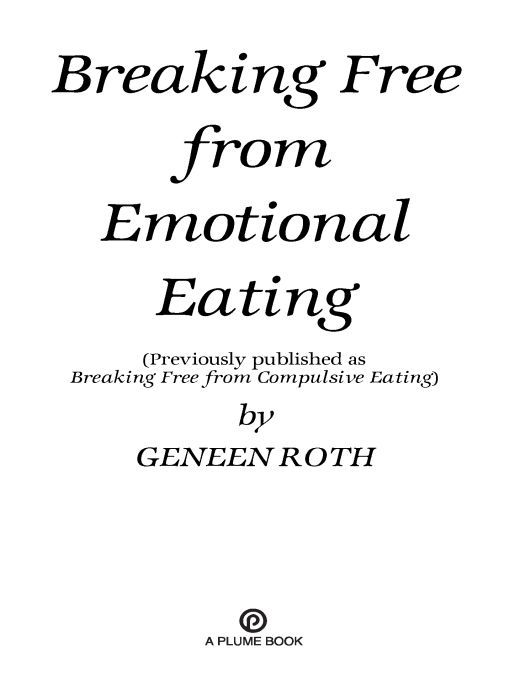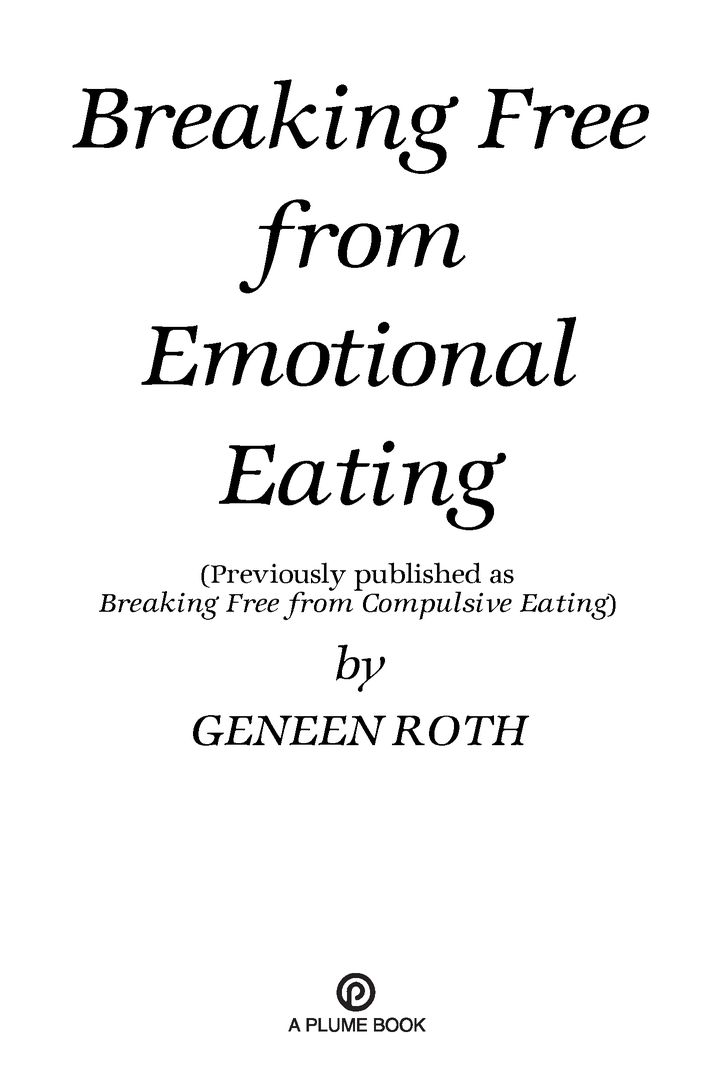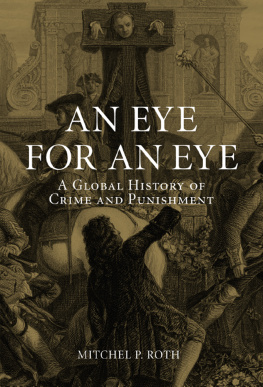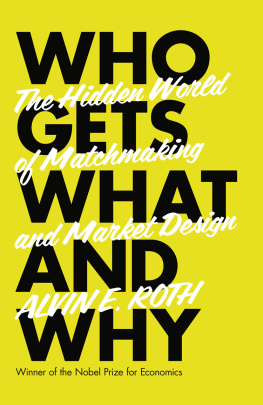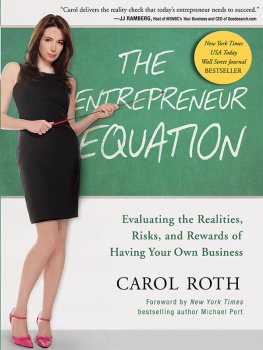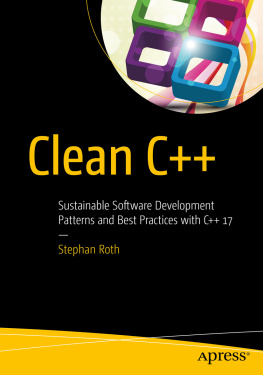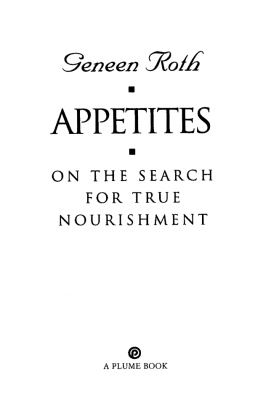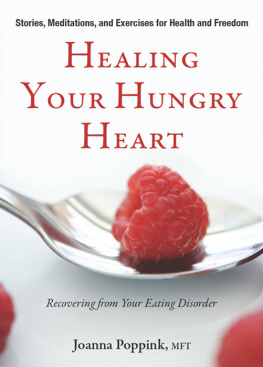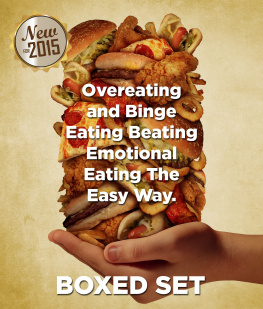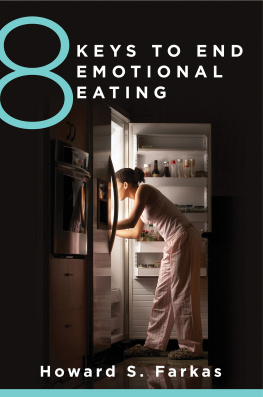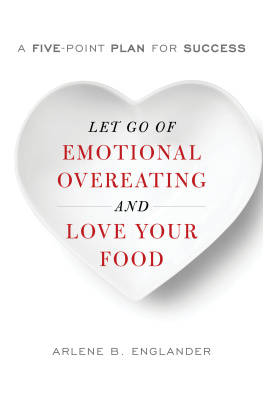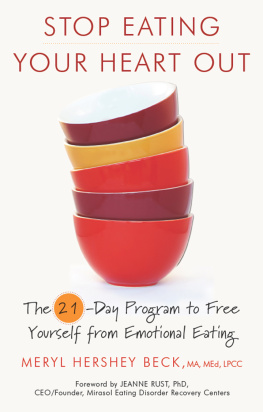Table of Contents
IF YOU USE FOOD TO FILL THE EMPTY SPACES OF YOUR LIFE...
... you probably know how to lose weight and how to gain it back again. How to stuff yourself or starve yourself. But what you probably dont know is how to tell when your body is really hungryand what you really want to eat.
More than just another diet book, this supportive guide to developing new eating habits works without forbidden foods, calorie counting, or deprivation. You will learn how to become more aware of both your physical and emotional needs, how to deal with the judgments of others, and finally, how to build a fulfilling life that revolves around something other than food. For all those held hostage by emotional eating problems, this book can be a passport to freedom.
Geneen Roth is a bestselling author and a teacher who has gained international prominence through her work in the field of eating disorders. She is the founder of the Breaking Free workshops, which she has conducted nationwide since 1979. She is also the author of Feeding the Hungry Heart, Why Weight?, and When Food Is Love (all available in Plume editions). A frequent guest on television and radio programs, she has been featured on Oprah and has written for Time, New Woman, Family Circle, and Cosmopolitan. Born in New York City, she now lives in northern California.
Visit geneenroth.com
Also by Geneen Roth
Appetites
Feeding the Hungry Heart
When Food Is Love
When You Eat at the Refrigerator, Pull Up a Chair
Why Weight?
To my mother, Ruth Wiggs
To my father, Bernard Roth
For their grace, humor, and willingness to participate in the struggle of loving and letting go. Thank you.
Acknowledgments
Every year I watch the Academy Awards, and every year at least one recipient drones on and on about his mother, who held his hands before he played Peter Pan in fifth grade, and his girlfriend Laurie, and his aunt Tessie, and his friend Raymond, without all of whom he wouldnt be standing here tonight. Every year I think, For Gods sake, get on with it.
This year, I realized that we never accomplish anything alone. This year I learned that my passion to write and my perseverance to sit through hours when words are stuck in concrete three miles away is about half of what it takes to write a book. The other half is the encouragement, sustenance, and loving welcome I receive from the people in my life.
Sara Friedlander gave me daily, and when it was needed, hourly perspective, faith, anchoring, and glue. By her tolerance for dissonance, generosity with her feelings, and ability to work at relationships, she has taught me not to leave love when it gets hard. I thank Agatha Coffey for her willingness to do whatever the need of the moment demands and for lighting up my world in the process. For his friendship, which continues to be a living matrix of all the qualities to which I aspire, I thank Lew Fein. For his unending patience, suggestions, and availability at any hour of the day or night, I thank David Avadon. For teaching me to trust what I know, seen and unseen, I thank Sally Blumenthal, my everyday friend. For pulling me like a kite back to earth and kitchen and hearth, I thank Estelle Fein. For her wise editorial advice, grounding, and commitment to our ever-deepening friendship, I thank Babs Bohn. For his reassurance and support throughout the year, I thank Bruce Bratton. For her enthusiastic and thoughtful reading of my manuscript, I thank Debby Burgard. For his interest and steady background support, I thank Cliff Friedlander. For renewing me by providing a place where words could fall away, I thank Linda Maldonado-Barman, Maria Ramirez, Rachel Lundquist, Ken Baker, and Christopher Smith. For inspiring me to honor the creative process by her own example, I thank Georgia Kelly. For receiving me and making a home for all my roles, I thank my parents, my brother, Howard Roth, and my stepfather, Richard Wiggs. And for stirring the memory of a dream by his combination of reticence at being met and stark insistence to meet, I thank my muse, Ralph.
For gifts that have heightened the quality of my life and my writing on a less personal but far-reaching basis, I thank Alexandra Kennedy for the foundation she helped to build; Joseph Goldstein, Jack Kornfield, and Alan Clements, whose words continue to awaken me; Harry and Susan Ungar for providing a place to begin my Breaking Free workshops; Karl Marhenke for my typewriter and the belief it embodied; Ellen Bass, Louise Thornton, Florinda Colavin, and Lucy Diggs for encouraging me at the beginning; the participants in the Breaking Free workshops for teaching me about courage and vulnerability and change; and the twenty-two women from around the country who contributed to Feeding the Hungry Heart and were never given the appreciation or recognition that their commanding part in the book deserved. Finally, for the birth of my second book-child, I thank my editor, Peg Parkinson, for the seed that only a parent can provide.
Introduction
In my previous book, Feeding the Hungry Heart, I described the humiliation of being called P.F.C. by boys in my high school. When the page proofs of the book arrived, I crossed out the story, then added it, then deleted it, then added it again. Although I believed that the telling of it would be helpful, the thought of revealing a secret I had never told anyone terrified me. I worried that people were going to make fun of me the way the boys in high school had. I worried that they were going to call me Pregnant Faced Cow. I was afraid in the way that the people I see in workshops are afraid: that if I told anyone the depths of my hell, they would use it against me, call me crazy.
Instead, readers called and they wrote to share their stories, their secrets. I was gratified and moved by the response to Feeding the Hungry Heart; it taught me that in the expression of what is raw and vulnerable, a healing can take place in the rawness and vulnerability of others. Still, the letters and phone calls were asking for more. One person wrote: I stayed up all night to finish your book. I feel like you understand me. But I dont know what to do now. Can you help? Another wrote: Please, Ms. Roth... Feeding the Hungry Heart is only a beginning. You let your readers feel understanding and acceptance for themselves, you gave us hope, but you left us without any way to implement it. We need another book.
I hadnt considered writing another book about compulsive eating; I wasnt sure I wanted to write another book about eating; I didnt know that I had anything further to say. But as the need became clear, the book asked to be written.
Breaking Free from Emotional Eating gathers all Ive learned in the past ten yearsin therapy, relationships, workshops Ive attended and led, retreats Ive participated in, lectures Ive given, letters and phone calls Ive received. The book is a compilation of years of learning and struggling and loving funneled into and adapted for the purpose of resolving the conflicts at the root of emotional eating. Because the process of breaking free is a very personal onewe all wrestle with different inner demons, though they manifest themselves in similar patterns of eatingthis book is a very personal one. It is a travelogue of sights, feelings, and situations that my clients and I passed as we attempted to come to peace with the anxiety-fraught relationship between ourselves and our bodies, ourselves and food.

